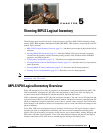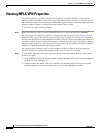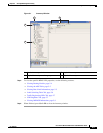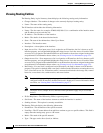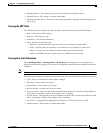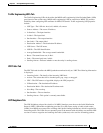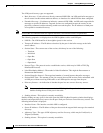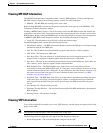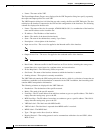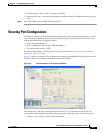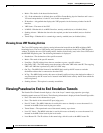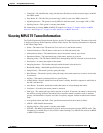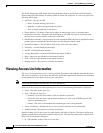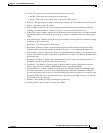
5-9
Cisco Active Network Abstraction 3.6.6 MPLS User Guide
OL-19192-01
Chapter 5 Viewing MPLS Logical Inventory
Viewing MPLS VPN Properties
Viewing MP-BGP Information
The MP-BGP branch displays information about a router’s BGP neighbors. Clicking the high-level
MP-BGP category displays the following property in the Cisco ANA workspace:
• MPBGP—The MP-BGP peer running on the local router.
Right-clicking MP-BGPs and choosing Properties displays the same property in the MPBGPs - FW
Component Container Properties window.
Clicking a MPBGP entity displays a list of the routers used in the MP-BGP network and includes the
configuration and status of the connections between the router displayed in the inventory and all other
BGP members. Right-clicking the MPBGP entity and choosing Properties displays the same properties
in MPBGP - [MP-BGP name} Properties window. The following information is displayed:
• Local AS—The Autonomous System (AS) to which the router belongs.
The BGP Neighbors table contains the following information:
• Peer Remote Address—The BGP peer remote IP address used by the BGP peer to exchange routing
information with the local BGP peer.
• Peer ID—The IP address by which the BGP recognizes and converses with its neighbor.
• VRF Name—The remote peer VRF name.
• Peer Keep Alive—The time interval in seconds between successive keepalive messages. The
keepalive time is negotiated with the neighbor after the connection is established.
• Peer State—The state of the connection between the local and remote BGP peers. Valid values are
Idle, Connect, Active, Open Set, Open Confirm, and Established.
• BGP Neighbor Type—The BGP neighbor type, either client or non-client. Route reflector
advertising is based on the BGP neighbor type. To client peers, a route reflector advertises all routes
learned from both client and non-client peers. To non-client peers, the route reflector advertises only
the routes received from client peers. For more information about route reflectors, see BGP
Neighbor Loss Scenario, page 8-5.
• Peer Hold Time—The BGP Hold Time value (in seconds) that is used when negotiating with peers.
If the router does not receive successive keepalive, update, or notification messages within the
period specified in the Hold Time field of the open message, the BGP connection to the peer is
closed.
• Peer Remote AS—The the remote peer AS.
• Distribute Through Interface—The local interface through which BGP information is distributed to
BGP neighbors.
• Sending Alarms—Not currently available.
Viewing VRF Information
Cisco ANA NetworkVision enables you to view VRF instances, and the import and export policies that
apply to each VRF.
Note The inventory window displays VRF associations only if they exist.
The following fields are displayed at the top of the VRF Properties dialog box:
• Route Distinguisher—The route distinguisher configured in the VRF.



